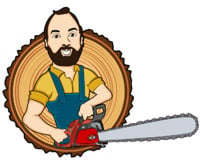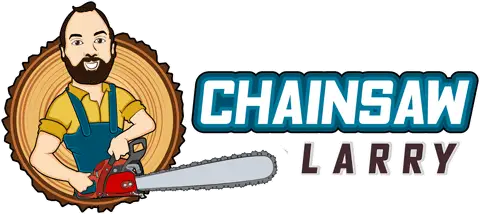Table of Contents
If you’re at all interested in chainsaws, the most common question you likely have is, “How does a chainsaw work?”
Sure, a chainsaw is well known for cutting up trees, but how does it do that exactly?
What are the components that make a chainsaw work?
Those are the types of questions we’re going to cover in this post.
So, let’s get to it!
But First…
If you’re in the market to buy a new chainsaw, I invite you to take a look at a few of my most popular buying guides.
These posts can help you find a chainsaw that’s perfect for your needs.
Those guides include the best chainsaw for cutting firewood, what to look for in the best 18 inch chainsaw for bigger jobs, and the top rated chainsaws available.
The Components of Chainsaw
Most simply put, a chainsaw works by spinning a chain of saw blades, also called “teeth”, around a guide bar quickly to cut through wood in a fast, smooth motion.
Sizes of blades/teeth and guide bars can vary greatly between chainsaws. The shortest guide bar, for example, is 6 inches while the largest can be up to 72 inches (or 6 feet).
Together, the chain and guide bar are referred to as the chain assembly which is powered by the engine/motor. The workings of the engine are the most complex aspect when answering the question, “How does a chainsaw work?”
But first, let’s review the main list of parts that work within a chainsaw:
- Starting Mechanism
- Engine
- Crankshaft
- Gear Wheels
- Chain Assembly (Guide Bar and Chain)
- Chain Brake
These main parts work together in the above order to power and operate a chainsaw.
Most chainsaws start through either the push of a button of the pull of a cord, depending on the type of energy used. The engine receives power from this starting mechanism and gives power to the crankshaft. Like a bicycle chain, the chain of the saw is rotated by gear wheels. The power of the crankshaft is what rotates these wheels.
As the gear wheels spin, the chain is rotated around the guide bar creating enough friction to be able to cut through wood. All modern chainsaws include a chain brake which stops the chain from spinning when a kickback occurs (a sudden thrust of the blade back toward the operator when the chain’s tip nicks a hard object).
Types of Chainsaws
Chainsaws work in a variety of ways. The types of chainsaws are differentiated by what kind of energy is powering the engine:
1. Gas
Gas chainsaws include a fuel tank which is fed into a carburetor to mix with air before passing into a cylinder where the gas is ignited to release energy. This energy is used to push a piston back and forth which causes the chain to turn in a circular motion.
2. Electric
Electric chainsaws receive energy by being plugged into an electrical outlet which powers a rod and crank assembly to power the circular motion of the chain. The main downside the electric chainsaws is that they’re not as portable as gas or battery operated chainsaws.
3. Battery
Battery powered chainsaws receive energy in the same way as electric chainsaws but from a lithium-ion battery instead of an electrical outlet. Because battery powered chainsaws are limited by the power they receive from the battery and must be charged often, they’re often not as powerful as electric or gas chainsaws.
Chainsaw Uses
Chainsaws are also different based on size and the amount of power they can produce.
The largest, most powerful chainsaws, can be used to cut down large trees while the most simple chainsaws can be perfect for trimming shrubbery in the backyard.
No matter what kind of chainsaw you buy, it’s important to exercise great caution when operating these powerful machines.
The fact is, whatever the woodcutting task, there’s a chainsaw ready for the job.
Dynamics of the Engine
The power behind the engine, also called its horsepower, depends most heavily on the amount of power it receives.
Each chainsaw is set up to handle a certain amount of energy depending on what job it’s intended for. The throttle and the clutch also work to control the energy of the engine.
The throttle within the engine controls the amount of energy, whether that be gas or electric, that gets to the engine.
Doing this, the throttle is able to control the revolutions per minute of the chain. The more energy released, the faster the chain will rotate.
Most chainsaws allow the operator to use the throttle to change the speed based on the needs of the project they are working on.
The engine also includes a clutch which uses suction to prevent the stalling of the engine if the chain encounters more difficult material. The clutch can also stop the chain rotation while keeping the engine running to prevent mistakes or injury.
Chainsaw Maintenance
Chainsaws can stop working if they’re not properly maintained.
Chainsaw maintenance varies depending on the type of chainsaw and the frequency of usage.
For the sake of safety, it’s important to perform basic checks before use, such as all screws and bolts are tight, gauges are working, chain brakes are engaging, proper chain tension, and all working parts are free of debris and are functioning properly.
Additionally, the sharpness of the blades on the chain will dull with age and use. Dull blades can be dangerous as they will cause the chainsaw to bounce away from the wood instead of cutting through.
Lastly, it’s key to ensure that the chain is adequately oiled and free of debris or sawdust so that the chain will rotate smoothly while in use.
Most importantly, read the manual for your specific chainsaw thoroughly to ensure successful use.
Chainsaws Work Well for Many Tasks
Chainsaws can be great tools to save time and energy for all woodcutting tasks when used properly.
The most common ways to use these machines is to cut down trees, split logs into firewood, cut up firewood, and trim bushes around the yard.
Now that you know more fully about how does a chainsaw work, you can better appreciate the way these tools cut wood.
As a reminder, if you’re interested in finding a new chainsaw for your home projects, I have a few helpful buying guides for you to check out.
The most popular ones include the best chainsaw for cutting firewood, what to look for in the best 18 inch chainsaw for bigger jobs, and the top rated chainsaws available.
Happy sawing!

Your pal,
Chainsaw Larry

